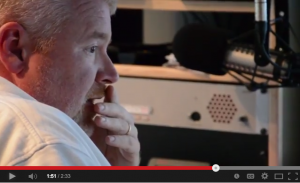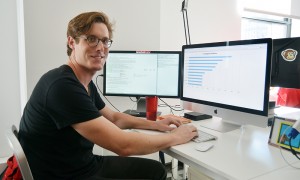BEING RADLER – Official Trailer from STATELESS MEDIA on Vimeo.
Editor’s note: This is one in an occasional series of articles profiling media startups.
By pairing investigative journalists with documentary filmmakers, “post-print” startup Stateless Media is discovering and sharing complex stories through video that used to be told exclusively through print outlets.
Journalist Peter Savodnik has created the concept of a “shortreal,” an 11-minute film that he said “marries the storytelling of print journalists with the cinematic prowess of the documentarian.”
“My sense has been that there has traditionally been a strong sort of delineation of different media types,” said Ed Perkins, a filmmaker who has worked with Savodnik on multiple shortreals. “I hope the shortreal can continue to push the boundaries of traditional media by blurring lines between news and film and entertainment.”
Stateless Media’s first shortreal, “The Brothers Shaikh,” tells the story of a man who was killed in a Sri Lankan hotel and that of his brother, who visits the scene of the crime.
It has been viewed 28,000 times. The second, “Chutzpah,” which follows Anthony Weiner around New York City, has 55,000 views, and 22,000 have watched the trailer for “Being Radler,” which explores the life of former East German spy Alexander Radler and is set to come out within the next few weeks.
However, Savodnik said it’s difficult to compile comprehensive statistics since the videos are being posted on multiple platforms, including Vimeo, the Stateless Media site and, in the case of The Brothers Shaikh, newyorker.com.
Savodnik said Stateless Media has 10 more shortreals under development, which will be filmed everywhere from the Middle East to southeast Asia to the United States, adding that the organization is looking to produce 50 to 100 in 2014. One of these was filmed at the request of a “big media company” whose name will not be disclosed until the shortreal is released in the next few months, he said.
The startup has been operating on a tight budget since Savodnik launched the project about nine months ago, but he said Stateless Media plans to take a “two-pronged approach” to financing: partnering with more large media organizations, which usually pay for production costs, and recruiting investors in order to update equipment and hire more employees.
Derek Poore, a film editor, photographer and multimedia producer who’s also a visiting assistant professor at the Missouri School of Journalism, said Stateless Media will have to figure out how to generate revenue from their shortreals in order to succeed.
“If you read any coverage of media, the big elephant in the room for the past 10 years is how are you going to make money off this, who’s gonna buy this, where will they show it, where will they place it,” he said. “That’s one hurdle.”
“Another big hurdle is the production value, but they obviously have the talent to produce well-done pieces,” he added. “They’ve found a way to produce really well-edited, well-shot short documentaries in a backpack style that a lot of people didn’t think was possible.”
Savodnik, Perkins and filmmaker Kannan Arunasalam — the core three involved in Stateless Media right now — work remotely. Each said the shortreals continue to improve as they refine their concept and become familiar with each other’s styles.
The process of making a shortreal takes two to three weeks from filming to posting the mini-documentary online, Savodnik said.
After three to five days of shooting, the director of each shortreal produces a rough cut, equal to about 60 percent of the total editing, which is then sent to a film editor to complete the rest of the work. Savodnik said this process varies from the traditional editing approach, which involves sending all the footage to an editor who hasn’t been directly involved with the film until then.
“We have both the perspective of the guy who’s been in the middle of the whole thing, in the middle of the maelstrom so to speak, and then you also have the perspective of the thoughtful outsider,” Savodnik said.
This method also allows each person to focus on what he does best — reporting, directing, editing — which hopefully produces a stronger story in the long run, according to Savodnik.
Arunasalam said filmmakers are usually responsible for the story as well as the filming, and he appreciates that he can concentrate on only the visual aspects of Stateless Media projects.
“It’s such a benefit for a filmmaker to know that [the reporting] is rigorous and rounded,” Arunasalam said. “You have this luxury of being able to anticipate how the story’s going to unfold.”
On the other hand, the stories and even the experience of shooting the films are meant to be unpredictable.
“Chutzpah” is fast-paced and snarky, filled with New Yorkers calling Weiner expletives. (Warning: it’s probably not safe for work, depending on where you work.)
CHUTZPAH from STATELESS MEDIA on Vimeo.
Though “The Brothers Shaikh” has a much more solemn tone, the Stateless Media team experienced plenty of nerve-wracking moments while shooting the shortreal.
While Nasser Shaikh was in the Sri Lankan hotel where his brother was killed, for instance, his microphone was disconnected. Having lived in Sri Lanka for many years, Arunasalam knew they could be “thrown out or worse” if they were caught with cameras there, so they had to pretend to be tourists while they fixed the setup in the bathroom.
THE BROTHERS SHAIKH from STATELESS MEDIA on Vimeo.
“That [experience] has definitely given me a lot to think about in future stories and where I will and won’t go in the future — not just country things but difficult and possibly dangerous places,” Arunasalam said. “Sometimes, you’ve just got to get in there.”
Savodnik said he continues to expand Stateless Media’s worker pool, mostly through his connections in the print industry; his previous work has been published in Bloomberg Businessweek, The New York Times Magazine and The Atlantic, to name a few. He said one of the more difficult aspects of the startup process has been explaining exactly what the organization does — “If it’s not a story, it’s not going to work.”
“If we care about empowering and strengthening the democracy, then journalists, the media needs to figure out a way right now to talk to people,” he said. “We’re doing a much better job of that.”







